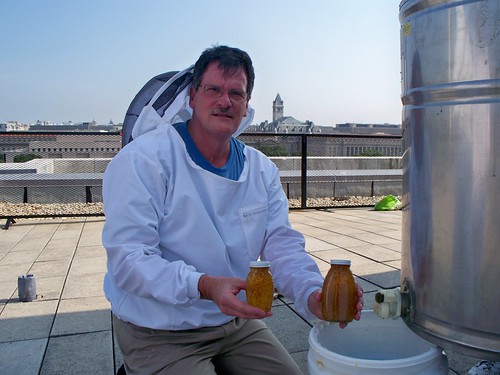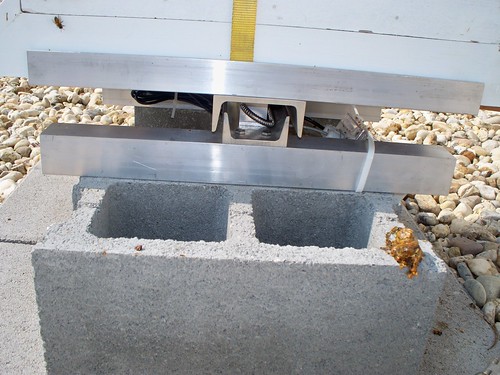This story has three parts. Read Part 1 here. Read Part 2 here.
For an hour or so, that’s how it went: on one side of the roof, I smoked the bees and removed capped frames, volunteers ran the capped frames over to the extractor on the other side of the roof, and the extractor team spun the honey out of the trays with the hand-cranked extractor. The centrifuged honey slid down the sides of the extractor into a sweet puddle at the bottom of the metal barrel. Everyone had a turn spinning the extractor (and maybe sneaking a taste of the fresh honey; but I can’t say for sure—I was on the other side of the roof).
Then the extractor broke! A couple of the teeth in the gear snapped off, making it impossible to turn the hand crank. Andy and Nathan decided to carry the extractor and the remaining full frames back to their office in Beltsville, Maryland, where they had another extractor and could finish the job.
But first, we wanted to pour the first two jars of honey. At the bottom of the exterior of the extractor barrel was a small tap. Leslie handed me two jars and I tapped the beautiful, clear honey into the jars. It was a proud moment for all of us.

From now on we’ll be able to monitor the hive for when the frames are full—and thus determine a good time to harvest the honey—without disturbing the bees. That’s because, while we were in the middle of the honey harvest, we lifted the hive and placed a scale under it. The scale has a data logger that will take readings of the hive every 10 minutes to evaluate weight gain and loss. So we’ll now know how much honey is in the hive without even cracking the lid.

In case you’re curious, we didn’t take all of the hive’s honey that day. We left the bees several partially full frames to build on. They feed the young that honey, and we didn’t want to make more work for them than we had to. After all, it’s hot out, and gathering nectar to make honey is hard work.
And after Nathan and Andy finished putting all the honey in jars, they put the extractor, with its streaks of honey, back on the roof for the bees to harvest. Now that’s what I call recycling!
For the latest updates, follow the People's Garden, NRCS and ARS on Twitter.
